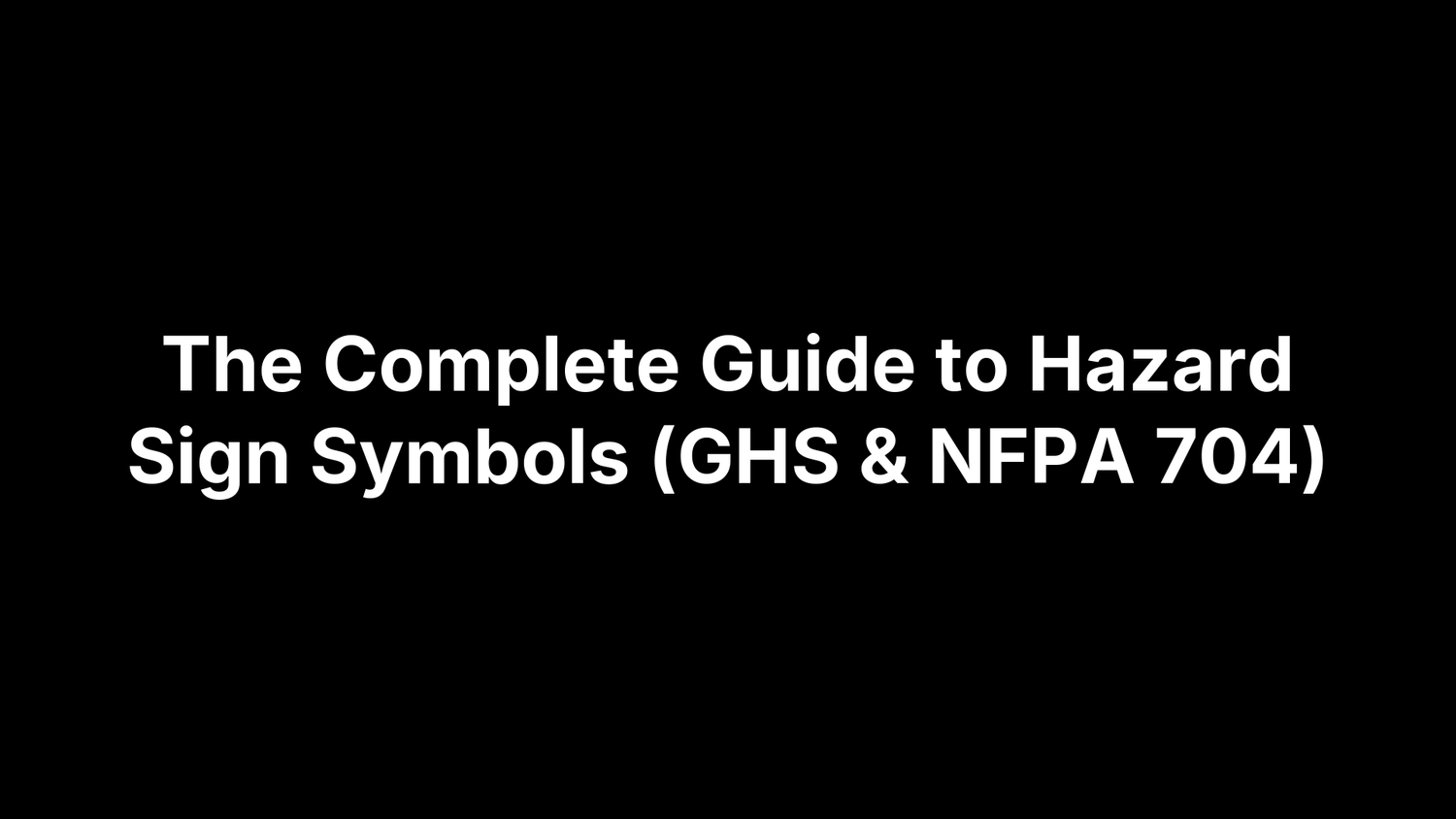The Complete Guide to Hazard Sign Symbols (GHS & NFPA 704)
Hazard sign symbols are standardized icons and color codes that instantly communicate risk—flammable, toxic, corrosive, explosive, and more. You’ll most often encounter two systems: GHS pictograms, the red-bordered diamonds used on chemical labels and Safety Data Sheets, and NFPA 704, the multicolor fire diamond that rates health, flammability, and reactivity at a glance.
This concise guide explains each GHS symbol and where it’s required (OSHA HazCom, WHMIS, SDS, and product labels), shows how to read the NFPA 704 diamond—including OX, W, and SA—and clarifies when to use each system. We’ll cover related signage, placement and legibility tips, durable materials for decals, how to create compliant labels, and a printable chart.
What is a hazard sign symbol?
A hazard sign symbol is a standardized graphic that communicates the type and severity of a risk at a glance. In workplaces and labs, this includes GHS hazard pictograms—black symbols on a white background with a red diamond border—and the NFPA 704 “fire diamond,” which uses color-coded quadrants (blue health, red flammability, yellow reactivity, white special). These symbols cut ambiguity, speed decisions, and support compliance on labels, SDSs, and signs.
GHS hazard pictograms explained
GHS hazard pictograms are standardized hazard sign symbols used worldwide to flag chemical risks on labels and Safety Data Sheets. Each is a black symbol on a white background within a red diamond border and maps to defined hazard classes (flammable, corrosive, acute toxicity, etc.). Labels pair pictograms with a signal word (“Danger” or “Warning”) plus hazard and precautionary statements. In the U.S., eight of the nine are mandatory; the environmental pictogram is optional.
The nine GHS symbols and what they mean
These red-diamond hazard sign symbols standardize how chemical risks are shown on labels and SDSs. Each pictogram corresponds to specific GHS hazard classes, so workers can identify dangers and choose controls quickly. Use the meanings below to train teams and audit labels for accuracy.
- Health Hazard: Carcinogen, mutagenicity, reproductive toxicity, respiratory sensitizer, target-organ toxicity, aspiration hazard.
- Flame: Flammable gas/liquid/solid; pyrophoric; self-heating; emits flammable gas; self-reactive; organic peroxide.
- Exclamation Mark: Skin/eye/respiratory irritant, skin sensitizer, acute toxicity (harmful), narcotic effects, STOT (Cat. 3).
- Gas Cylinder: Gases under pressure (compressed, liquefied, refrigerated liquefied, dissolved); some chemicals under pressure.
- Corrosion: Skin corrosion/burns, serious eye damage, corrosive to metals.
- Exploding Bomb: Explosives; highly unstable self-reactives and organic peroxides (Types A/B).
- Flame Over Circle: Oxidizers (gases, liquids, solids) that intensify fire.
- Skull and Crossbones: Severe acute toxicity (oral, dermal, inhalation; Categories 1–3).
- Environment: Aquatic toxicity; note: non-mandatory under OSHA HazCom in the U.S.
Where GHS symbols are used (OSHA HazCom, WHMIS, SDS, labels)
GHS pictograms are the backbone of chemical hazard sign symbols on labels and Safety Data Sheets. In the U.S., OSHA’s Hazard Communication Standard requires applicable pictograms on shipped container labels alongside a signal word, hazard statements, and precautionary statements; the environmental symbol is optional. In Canada, WHMIS (aligned with GHS) requires pictograms on supplier labels and SDSs. You’ll also see the same symbols echoed in training materials and workplace labels to maintain consistency with the SDS.
- Shipped container labels (OSHA HCS): Red-diamond pictograms when hazards apply.
- Safety Data Sheets (Section 2): Pictograms or their names appear with hazard statements.
- WHMIS supplier labels (Canada): GHS-aligned pictograms and required text elements.
- Workplace labels/signs: Mirror SDS hazards for secondary containers and posted notices.
NFPA 704: how to read the fire diamond
The NFPA 704 “fire diamond” is a quick-read hazard sign symbol used on rooms, doors, and tanks to tell responders what’s inside and how dangerous it is. Four quadrants show different risks: blue (health), red (flammability), yellow (reactivity), and white (special). Numbers 0–4 indicate increasing severity—the higher the number, the higher the risk.
- Blue—Health: 0 minimal; 2 temporary incapacitation; 3 serious or permanent injury with short exposure; 4 life-threatening on brief exposure.
- Red—Flammability: 0 will not burn; 1 flash point >200°F; 2 flash point <200°F; 3 flash point <100°F; 4 flash point <73°F and rapidly vaporizes.
- Yellow—Reactivity: 0 stable; 1 unstable with heat/pressure; 2 violent reaction; 3 may detonate with heat/shock/water; 4 may detonate under normal conditions.
- White—Special: Space for specific warnings (e.g., oxidizer, water-reactive, simple asphyxiant).
NFPA 704 ratings and special codes (OX, W, SA) demystified
Beyond the 0–4 numbers, the white quadrant of the NFPA 704 fire diamond adds short codes to flag unusual hazards so responders choose the right tactics fast. Use these correctly to avoid dangerous assumptions during an emergency.
- OX: Oxidizer—can intensify fire; lets other materials burn without air.
- W (with a bar): Water-reactive—do not use water; reacts violently.
- SA: Simple asphyxiant gas (e.g., nitrogen)—displaces oxygen.
Facilities may also post additional notices (per local policy), such as Radioactive, Poison, Biohazard, Corrosive/Strong Acid/Strong Alkaline, or Cryogenic to highlight specific risks.
GHS vs NFPA 704: differences, similarities, and when to use each
Both systems are standardized hazard sign symbols designed for fast, accurate risk recognition—but they serve different moments. GHS pictograms travel with the product on labels and Safety Data Sheets, while NFPA 704 is posted on rooms, doors, tanks, and designated areas to guide emergency response at a glance.
- Differences: GHS uses red-diamond pictograms with text elements for classification and communication on shipped containers/SDS; NFPA 704 uses a color diamond with 0–4 numbers (plus special codes) to rate on-site health, flammability, and reactivity.
- Similarities: Both standardize hazard visuals, improve comprehension, and complement training and labeling programs.
- When to use each: Use GHS on container labels and SDSs (OSHA/WHMIS). Use NFPA 704 on fixed locations and bulk storage to inform responders and occupants.
Related signage: DOT hazmat placards and ANSI signal words
Not all hazard sign symbols serve the same moment. DOT hazmat placards are transport-only markings for trucks, railcars, and bulk packages; they identify one of nine hazardous materials classes (e.g., Explosives, Gases, Flammable Liquids) during shipping—not workplace labeling. In facilities, ANSI/OSHA-style safety signs use standardized signal words and symbols to convey severity and action, complementing (not replacing) GHS and NFPA systems.
- DOT placards: Vehicle-level, class-based identifiers for transport.
- Signal words: Use with symbols and clear text (e.g., “Danger,” “Warning”) to indicate severity and required precautions.
Placement, size, and legibility best practices
Good hazard sign symbols only work if people can see and understand them the moment they’re needed. Place GHS pictograms where chemicals are stored and used (on primary and secondary containers) and post NFPA 704 fire diamonds at room entrances, doors, and tanks. Keep symbols unobstructed, correctly formatted (red border, white background), and readable at the approach distance.
- Mount in the line of sight: Near storage, mixing, and transfer points.
- Scale for distance: Size labels so symbols read clearly before handling.
- Preserve format: Keep the red diamond intact on a white background.
- Maximize contrast: Use high-contrast colors; choose matte to reduce glare.
- Avoid clutter: Provide clear space; display only applicable pictograms.
- Keep upright and flat: Don’t wrap over edges or curved transitions.
- Light the area: Ensure signs are visible under normal and emergency lighting.
- Inspect and replace: Swap any faded, torn, or contaminated labels promptly.
- Align with documents: Match workplace labels to SDS Section 2; match NFPA postings to actual on-site hazards.
Materials and durability: what to look for in hazard decals
Hazard decals must withstand real conditions so your hazard sign symbols stay readable. Choose industrial-grade films and inks that resist UV, chemicals, and abrasion, and match adhesives and finishes to the surface and lighting. ORAFOL films and ORALITE conspicuity sheeting provide proven visibility and durability.
- UV protection: UV-stable inks + matte overlaminate.
- Chemical/abrasion resistance: Suitable for routine cleaning.
- Right adhesive: Match to substrate and temperature.
- Visibility: Reflective or high-contrast films for low light.
How to create compliant custom labels and signs
Compliance is easier with a repeatable workflow. Decide first if you’re labeling a chemical container (GHS under OSHA/WHMIS) or a fixed location/tank (NFPA 704), then pull the right information from the SDS and your hazard inventory. Use the steps below to produce clear, compliant hazard sign symbols.
- Pick the standard: GHS for shipped/secondary containers and SDS alignment; NFPA 704 for rooms, doors, and tanks.
- Gather source data: Use SDS Section 2 for GHS pictograms, signal word, hazard and precautionary statements; confirm NFPA 0–4 ratings and any special codes (OX, W, SA).
- Assemble elements: GHS—red diamond pictograms on white, correct signal word, hazard and precautionary statements. NFPA—blue/red/yellow numbers with applicable white-quadrant codes.
- Format for legibility: Size for viewing distance, preserve red border on white, use high contrast, and avoid non-applicable symbols.
- Select durable materials: UV/chemical-resistant films, correct adhesive, and reflective/hi-vis where needed; ORAFOL and ORALITE options help longevity.
- Validate and train: Verify against the SDS and site postings, then train users on meanings and response actions. Safety Decals can streamline this with a sticker builder and compliance support.
Printable GHS and NFPA 704 chart (downloadable)
Grab a one-page, printable chart (PDF) that pairs all nine GHS hazard pictograms with plain-language meanings and shows the NFPA 704 fire diamond with 0–4 ratings plus OX, W, and SA codes. Print letter or tabloid size, laminate, and post near chemical storage for instant hazard sign symbol reference.
Frequently asked questions
Here are quick answers to the questions safety managers ask most about hazard sign symbols, from GHS pictograms on container labels to NFPA 704 postings on doors and tanks. Use these as a fast check against your SDSs, training, and posted signage. When in doubt, follow the governing standard for your application.
- Is the environmental GHS pictogram required in the U.S.? No. It’s non-mandatory under OSHA HazCom.
- Do GHS pictograms need a red diamond border? Yes—black symbol, white background, red frame.
- What do NFPA 704 colors mean? Blue health, red flammability, yellow reactivity, white special (e.g., OX, W, SA).
- Can I use NFPA 704 instead of GHS on shipped containers? No. Use GHS for containers; NFPA 704 for rooms, doors, and tanks.
Key takeaways and next steps
You now have a clear, practical map: use GHS pictograms on containers and SDSs, and post NFPA 704 on rooms, doors, and tanks. Support both with disciplined placement, legible sizing, durable materials, and routine training so people recognize hazards and act fast.
- Audit: labels/signs against SDS Section 2 and inventory.
- Confirm: NFPA 704 numbers and special codes (OX, W, SA).
- Train: teams on symbol meanings and responses.
- Get: the chart and compliant decals at Safety Decals.


